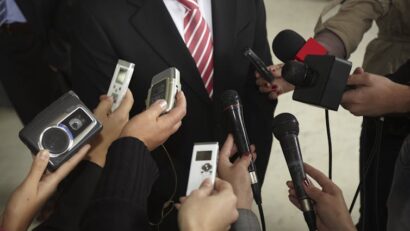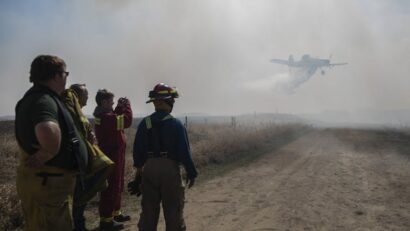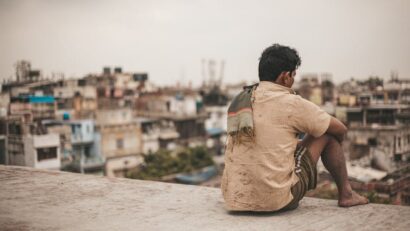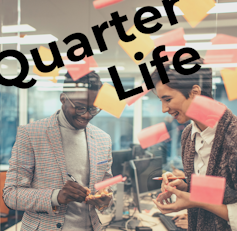
After Just for Laughs’ bankruptcy, we should ask Canadian comedians what they need to succeed
It’s still not clear how Juste Pour Rire / Just for Laughs (JPR/JFL) went from one of the biggest comedy festivals in the world to bankruptcy.
On April 12, La Presse reported the festival lost $800,000 in an email phishing scheme in 2023. This is just the latest detail emerging after Groupe Juste pour rire inc. announced the cancellation of the 2024 edition of JPR/JFL as well as the layoffs of 70 per cent of its workforce.
The company also applied for protection from creditors under the Bankruptcy and Insolvency Act. A week before the company announced this, a bailiff seized more than $800,000 in assets because of a Québec Court of Appeal decision on a bizarre contract disagreement with an archivist/former employee who was promised a job for life.
Documents filed in Montréal reveal the company was $22.5 million in debt, with an additional $3.4 million owing to a long list of creditors that included television stations, production companies, marketing firms and even a dépanneur (local convenience store).
With large-scale government funding that has previously gone to JPR/JFL potentially now up for grabs, there is an opportunity to reconsider and restructure our national comedy industry.
From burst to bust
JPR was founded by businessman Gilbert Rozon in 1983 as a two-day French-language comedy event in Montréal. In 1985, Rozon was joined by promoter Andrew Nulman who brought the event to anglophone audiences and co-founded the company’s bilingual iteration.
JPR/JFL is a behemoth in Canadian comedy and tourism. The flagship festival still took place in Montréal but expanded nationally and globally.
A news crew in front of the Just for Laughs theatre in Montréal, March 5, 2024.
THE CANADIAN PRESS/Ryan Remiorz
Conflicts around sexual assault, harassment
In recent years, JFL has contended with a series of high-profile conflicts. At the height of #MeToo in 2017, Rozon stepped down as president after being named in numerous sexual assault allegations.
This also brought back to light Rozon’s previous 1998 sexual assault charge that he plead guilty to. In 2020, Rozon was found not guilty of rape and indecent assault. In 2022, more allegations emerged.
Just for Laughs founder Gilbert Rozon walks past demonstrators as he arrives at the courthouse to hear the closing arguments in his sexual assault trial in Montréal in November 2020.
THE CANADIAN PRESS/Paul Chiasson
The festival was also accused by journalist and comedian Megan Koester of shutting down an attempt to investigate the accusations of sexually inappropriate behaviour from comedian Louis C.K., which C.K. later admitted to.
As I have written elsewhere, sexualized violence is rampant in the comedy industry. In 2018, after tying for first at the Montréal festival’s Homegrown Comics competition, comedian and writer D.J. Mausner publicly rejected their prize — the taping of a stand up special — and called for a boycott of JPR/JFL.
Read more:
Louis C.K.: Sexual misconduct and the pursuit of justice
Mausner said Rozon’s stepping down was a “a surface-level solution for a systemic problem” and called the festival an “accessory to sexual assaults.”
Following the earlier assault allegations, the organization implemented an
anti-harassment policy and brought in new investment partners.
Royalties issues, pandemic challenges
Then, in 2019, SiriusXM Canada and JPR/JFL announced a partnership to take over the Canada Laughs radio channel. The channel, which once played exclusively Canadian content, would now primarily feature classic JPR/JFL recordings, meaning a substantial reduction in royalties for Canadian comedians.
Intense public pushback from comedians led JPR/JFL to walk back their proposal and commit to playing 100 per cent Canadian content.
In their official statement on the 2024 festival cancellation, Groupe Juste pour rire inc. cited COVID-19, inflation, a changing media landscape and difficult times for festivals as reasons for the 2024 cancellation.
It is clear that the rise of social media and streaming services have drastically changed the comedy landscape. The pandemic hit live festivals hard, but JPR/JFL did receive significant monetary assistance from government sources. Despite the real disruptions the company faced, there is confusion about how a well-funded comedy festival managed to dig itself so deep in debt.
The Montréal-born Just For Laughs festival grew international offshoots including in Chicago and Sydney, Australia. Comedian Martin Short at a press conference at the Opera House in Sydney, Australia, in 2011.
(AP Photo/Rob Griffith)
Blockbuster festivals, broke comedians
Canadian comedians often think of performing at JPR/JFL as a massive career goal. This makes its cancellation a brutal loss. As comedian Cassie Cao told CBC host Elamin Abdelmahmoud, JPR/JFL is a huge deal for Canadian comics who have “so little else in the industry.” A 2019 study from SponsorPulse found that 49 per cent of Canadians engaged with JPR/JFL over a year (meaning, they either watched on live television or online, or followed news events or social media), which suggests that platforming Canadian comedians could have a huge impact on their careers. But for years, JPR/JFL has been taken to task for their prioritization of American comedians.
Even if JPR/JFL survives restructuring, comic Sam Sferrazza says this likely will mean “bringing in more bankable American talent paid for by Canadian taxpayers and artistic institutions.”
Canadian funding agencies tend to favour blockbuster events like JPR/JFL but in the world of art grants, stand-up comedians are at a disadvantage. Lumped in with other groups like theatre performers, comedians are, Sferrazza says, forced to “compete with completely different art forms.”
JPR/JFL’s monopoly of the industry is evidently not working, so what do we need to build a real and sustainable foundation for Canadian comedy?
Boosting international exposure
In my doctoral research and book chapter on work in the Canadian comedy industry, I found that most comedians felt that to make a real living off comedy, they’d have to leave Canada. But what if we created an environment where they not only wanted to stay but could stay.
One option is boosting Canada’s comedic digital content internationally. CBC Gem, for example, is accumulating an impressive catalogue of stand-up, but they are restricted to Canadian viewers. While there is nothing wrong with Canadian content for Canadian audiences, it ultimately puts a ceiling on comedians’ visibility. Expanding the circulation of our comedic content and continuing to invest in producing stand-up specials — which is relatively low cost — could be a huge boon to the careers of Canadian comedians.
Funding for local comedians and festivals
Another option is putting more funding directly into the pockets of individual Canadian comedians, producers, and (smaller) festivals, strengthening the comedy industry nationwide. While my study focused on Toronto, there are flourishing independent comedy scenes all over the country. These scenes are often where cutting-edge comedy is being created by diverse performers who might never have made it to, or felt welcomed on, a JPR/JFL stage.
In reimagining the industry, we shouldn’t be taking a top-down approach. We need to be asking comedians what they need to succeed and recognizing their work as both artists and contributors to Canadian culture.
While the potential end of JPR/JFL is a loss, it is also a wake-up call to rethink how we support and structure our comedy industry. Läs mer…








